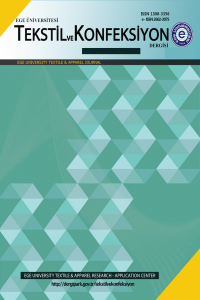Investigation of the Effects of Embroidery Parameters on Physical Properties and Thermal Comfort
Investigation of the Effects of Embroidery Parameters on Physical Properties and Thermal Comfort
Embroidery, Embroidery parameters, Thermal comfort, Embroidery stitch density Fusing paper,
___
- Toprakkaya D., 1999. Termofizyolojik Açıdan Giyim Konforu. Tekstil ve Konfeksiyon, 9(5), 403-407.
- Çivitci Ş., Dengin S., 2014. Koşu Giysileri Konforunun Kullanıcılar Tarafından Değerlendirilmesi Üzerine Bir Araştırma, International Journal of Science Culture and Sport July, Special Issue 1 pp.553-569.
- Ünal Z., Acar E., 2017. Nakış Türlerinin ve Nakış Kalitesini Etkileyen Parametrelerin Araştırılması, Uluslararası Geleneksel Sanatlar Sempozyumu, Trabzon. Emekli F., 2017. Nakış Kalitesini Etkileyen Parametrelerin Değerlendirilmesi, Master’s Thesis, Ege University Graduate School of Natural and Applied Science, İzmir, 29-43.
- Oğlakcıoğlu N., Marmaralı A., (2010), Rejenere Selüloz Liflerinin Kompresyon Çoraplarının Isıl Konfor Özelliklerine Etkisi, Tekstil ve Mühendis, 17(77), 6-12.
- Oğlakcıoglu N., Çelik P., Bedez Üte T., Marmaralı A., Kadoğlu H., 2009. Thermal Comfort Properties of Angora Rabbit/Cotton Fiber Blended Knitted Fabrics, Textile Research Journal, 79(10), 888-894.
- Süpüren G., Oğlakcıoğlu N., Özdil N., Marmaralı A., (2011). Moisture Management and Thermal Absorptivity Properties of Double-Face Knitted Fabrics, Textile Research Journal, 81(13), 1320-1330.
- Yavaşcaoğlu A., Eren R., Süle G., 2018. Effects of Usage Acrylic Yarn on Thermal Comfort and Moisture Management Properties of Woven Shirting Fabrics, Textile and Apparel, 28 (2), 141-150.
- Islam A., Rokonuzzaman and Zayedul H., 2018. Analysis on thermal comfortability of different three thread fleece fabric, International Journal of Current Engineering and Technology, Vol.8, No.6, 1675-1678.
- Troynikov O, Wardiningsih W, 2011. Moisture Management Properties of Wool/ Polyester and Wool/Bamboo Knitted Fabrics for the Sportswear Base Layer, Textile Research Journal, 81(6), pp. 621-631, https://doi.org/10.1177/0040517510392461, web: https://journals.sagepub.com/doi/pdf/ 10.1177/ 004051751039 2461, 81(6), pp. 621-622.
- Süpüren Mengüç G., 2020. Studies on Moisture Management Properties of Various Textile Products. Turkish Journal of Fashion Design and Management, 2 (1), 31-35.
- Erdoğan M. Ç., (1993). Giysi Fizyolojisi, Tekstil ve Konfeksiyon, 33, 63-66.
- Marmaralı A., Oğlakcıoğlu N., Dönmez Kretzschmar S., 2006. Thermal Comfort and Elastic Knitted Fabrics, CIRAT-2 (The Second International Conference of Applied Research on Textile), Bildiri kitabı, 30.11.2006/02.12.2006, Monastir, Tunus.
- Oğlakcıoğlu N., Marmaralı A., 2007. Thermal Comfort Properties of Some Knitted Structures, Fibres&Textiles in Eastern Europe, 15 (5-6/64-65), 94-96. Marmaralı A., Oğlakcıoğlu N., 2013. Giysilerde Isıl Konfor; 11. Ulusal Tesisat Mühendisliği Kongresi, İzmir, 1957-1963.
- Taştan Özkan E., Meriç Kaplangiray B., 2015. Askeri Giyimde Kullanılan Dokuma Kumaşların Nem İletimi Özelliklerinin İncelenmesi. Uludağ University Journal of the Faculty of Engineering, 20 (1), 51-63.
- Oğlakcıoğlu N., İlleez, A., Erdoğan M.Ç. , Marmaralı A., Güner M., 2013. Bisikletçi Giysilerinde Dikim İşleminin Isıl Konfor Özelliklerine Etkisi. Tekstil ve Mühendis, 20 (90), DOI: 10.7216/130075992013209004.
- ISSN: 1300-3356
- Yayın Aralığı: Yılda 4 Sayı
- Başlangıç: 1991
- Yayıncı: Ege Üniversitesi
A Novel Approach for Optimum Planning of Bobbin Boilers in Textile Industry
Stochastic Modelling of Pilling Degree Changes During the Pilling Process of Wool Fabrics
Özge ELMASTAŞ GÜLTEKİN, Aslı KILIÇ, Gonca ÖZÇELİK KAYSERİ
Erkan Türkmen DÖNMEZ, Erkan TURKER
Lateral Compression Properties of Special-Shaped 3D Tubular Woven Composites
Lvlihua LVLİHUA, Tingting LYU, Jingjing WANG, Xiaoqing XIONG
Comparative Analysis of PET, PTT and PBT Yarns Hydrolyzed by Alkali
Vidhya M, Parveen Banu K, Vasanth KUMAR D, Chidambaram PRAKASH, Subramaniam SUBRAMANİAM V4
Investigation of the Effects of Embroidery Parameters on Physical Properties and Thermal Comfort
